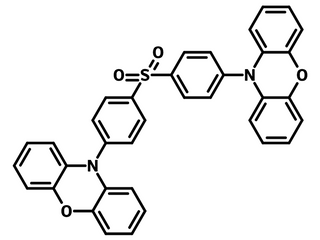PXZ-DPS
CAS Number 1477511-57-1
Dopant Materials, Fluorescent Host Materials, Green Dopant Materials, High Purity Sublimed Materials,PXZ-DPS, ideal green emitter for TADF-OLED devices
High photo-luminescence quantum yields and purity (>99.0%), 10,10′-(sulfonylbis(4,1-phenylene))bis(10H-phenoxazine), CAS No. 1477511-57-1, Sublimed ≥99.0%
PXZ-DPS possesses a structure of a weak electron-accepting diphenylsulfone and strong electron-donating acridine moieties. It is used as a TADF green emitter or dopant, and has a small ΔEST of less than 0.1 eV, a short lifetime of less than 3.1 µs.
Like DMAC-DPS, PXZ-DPS has high photo-luminescence quantum yields (PLQY) in devices even with the change of host materials. It is an ideal candidate for applications in green TADF-OLED devices with biploar charge-transporting capability.
General Information
| CAS number | 1477511-57-1 |
|---|---|
| Full name | 10-(4-(4-(10H-Phenoxazin-10-yl)phenylsulfonyl)phenyl)-10H-phenoxazine |
| Chemical formula | C36H24N2O4S |
| Molecular weight | 580.65 g/mol |
| Absorption | n/a |
| PL | λem 507 nm in toluene |
| HOMO/LUMO | HOMO = 5.59 eV, LUMO = 2.79 eV; T1=2.74 eV, ΔEST = 0.08 eV [1] |
| Synonyms | DPS-PXZ |
| Classification / Family | Acridine derivatives, TADF green emitter, TADF green host materials, Sublimed materials |
Product Details
| Purity | Sublimed >99.0% (HPLC) |
|---|---|
| Melting point | TGA > 220 °C (0.5% weight loss) |
| Appearance | Off-white powder/crystals |
*Sublimation is a technique used to obtain ultra pure-grade chemicals. For more details about sublimation, please refer to the Sublimed Materials.
Chemical Structure
Device Structure(s)
| Device structure | ITO/a-NPD (30 nm)/TCTA (20 nm)/CzSi (10 nm)/PXZ–DPS:DPEPO (20 nm)/DPEPO (10 nm)/TPBI (30 nm)/LiF (1 nm)/Al [2] |
|---|---|
| Color | Green |
| Max EQE | 17.6% |
| Device structure | ITO/TAPC (30 nm)/TCTA (10 nm)/PXZ-DPS:0.5 mol% PhtBuPAD* (30 nm)/BPBiPA (40 nm)/LiF (0.5 nm)/Al (150 nm) [2] |
|---|---|
| Color | Green |
| Max EQE | 19.3% |
| Max. Power Efficiency | 48.5 lm W-1 |
| Device structure | ITO/TAPC (30 nm)/TCTA (10 nm)/PXZ-DPS:PhCzTRz:0.5 mol% PhtBuPAD* (30 nm)/BPBiPA (40 nm)/LiF (0.5 nm)/Al (150 nm) [2] |
|---|---|
| Color | Green |
| Max EQE | 24% |
| Max. Power Efficiency | 71.4 lm W-1 |
*For chemical structure information, please refer to the cited references.
MSDS Documentation
Literature and Reviews
- Efficient blue organic light-emitting diodes employing thermally activated delayed fluorescence, Q. Zhang et al., Nat. Photonics, 8, 326–332 (2014); DOI: 10.1038/nphoton.2014.12.
- Blocking Energy-Loss Pathways for Ideal Fluorescent Organic Light-Emitting Diodes with Thermally Activated Delayed Fluorescent Sensitizers, D. Zhang et al., Adv. Mater., 30, 1705250(2018); DOI: 10.1002/adma.201705250.
- Recent progress of green thermally activated delayed fluorescent emitters, Y. Im et al., J. Info. Display, 18:3, 101-117 (2017); DOI: 10.1080/15980316.2017.1333046.

